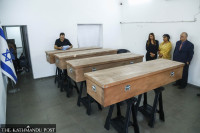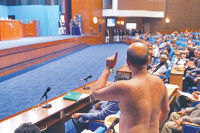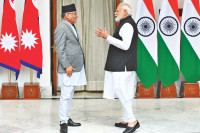Special Supplement
2018 brought more visitors and more money to Pokhara
The year 2018 proved to be a banner year for Pokhara when the lake city welcomed nearly 30 new hotels, and the number of overnight visitors jumped to more than a million. Hotels have not only proliferated, their revenue has hit record highs.
Sangam Prasain & Lal Prasad Sharma
The year 2018 proved to be a banner year for Pokhara when the lake city welcomed nearly 30 new hotels, and the number of overnight visitors jumped to more than a million. Hotels have not only proliferated, their revenue has hit record highs.
The gateway to the world-famous trekking destination on the slopes of the Annapurna range, Pokhara is in an upbeat mood as it readies to inaugurate Nepal’s third international airport by 2020. The adventure sports playground of Pokhara offers boating, paragliding and mountain biking. It has scenic lakes, gourmet restaurants and fascinating souvenir shops. Gandaki Province, where Pokhara is located, aims to host two million domestic and foreign tourists in 2020.
Tourist arrival statistics of the Ministry of Tourism of Gandaki Province shows that in the first five months of the current fiscal year which began mid-July, 144,195 foreign thrill seekers visited Pokhara. Among them, 58,895 were Indians. “The lake city receives tourists round-the-year,” says Bikal Tulachan, chairman of the Hotel Association of Nepal Western Region Chapter. “As per our estimate, one million tourists visited Pokhara in 2018, and among them, 60 percent were Nepalis.”
The industry nearly lost heart when hotel occupancy rates plunged to less than 30 percent in 2015, following the twin disasters of a devastating earthquake and crippling trade embargo. Hotels hadn’t faced such hard times since the Maoist conflict which lasted from 1996 to 2006. But in 2016, there was a positive change as domestic adventure seekers started arriving in droves. “Domestic tourist movement continued in 2017. This year was an exceptional year in terms of domestic visitors,” says Tulachan. According to Tulachan, 30 new hotels were added in 2018, producing more than 500 rooms; and another two dozen hotels are on track to open in 2019. “This year, the average occupancy of Pokhara’s hotels jumped to 60 percent due to swelling domestic arrivals.”
In the hospitality sector, an occupancy rate of above 40 percent is considered ‘survival’, and a rate higher than 50 percent is termed ‘fair’. An occupancy rate of above 60 percent is ‘good’, and 70 percent and higher is ‘excellent’. Pokhara’s hoteliers are now looking towards the future. But there are problems—the beautiful city has not been able to increase the length of stay and spending of the visitors.
“The length of stay of visitors in Pokhara is poor. They stay here for only two days,” says Roshan Khawas, general manager of the Pokhara Grande. “This is because Pokhara has been established as a transit point to various famed trekking destinations including Mt Annapurna. This obviously needs to be changed.”
Khawas believes that tourists will arrive here directly after the new international airport comes online. There will be direct connections with major cities in China and India, the key sources of tourists to Pokhara. “Pokhara can be the best destination for meetings, incentives, conferences and exhibitions (MICE), a type of tourism in which large groups, usually planned well in advance, are brought together. “We have an opportunity to establish Pokhara as a world-class leisure destination,” he says. “We need to devise packages to lengthen tourist stay to at least five days.”
This year, most of the hotels in Pokhara have reported record earnings. Hoteliers said that the average room rates of luxury hotels rose to $70 from $50 while medium range hotels were able to sell their rooms for $30-40 per night. “But this is not enough. Given the potential of Pokhara, the tariff is very low.” As a result, many international guidebooks have featured Pokhara as one of the cheapest destinations in the world. In 2016, Forbes magazine published its list of ‘20 best value cities for budget travelers’ placing Pokhara at the top. Pokhara was described as the cheapest place where one could stay for $15.84 per night. It was followed by Hanoi and Ho Chi Minh City (formerly Saigon) in Vietnam with daily budgets of $17.13 and $18.30 respectively. “Obviously, undercutting rates and fostering unhealthy competition is the biggest problem in Pokhara,” says Toyanath Paudel, operation manager of the Atithi Resort and Spa in Pokhara.
“Hotel revenue has increased by 25-30 percent in 2018, but the rates offered by hotels here are probably the lowest in the Asian region.”
Ten years ago, a room in a three-star hotel cost $20 to $25 per night. And in 2018, a room could be reserved for as less as $30. And if tourist movement starts to drop, it can be reserved for $10. “Improving services for holidaymakers is the key to attracting more tourists,” says Paudel.
“We are at a crossroads. We have to find more skilled labour and enhance services instead of resorting to undercutting which has eroded the reputation of hotels.”
Aagraha Aryal, executive director of the Hotel Crown Himalayas, says bookings to Nepal have rebounded. Accordingly, many luxury hotels are also coming to Pokhara in a big way. “Obviously, the old players will be under pressure once luxury properties start entering the lake city. We are also upgrading ourselves to a four-star property.”
Aryal says that 2018 ended with an average 60 percent occupancy; and given booking trends for 2019, occupancy might go up 10 percent.
Nepali tourists are the new hope of Pokhara tourism as they have started to go trekking in the Annapurna region. In the past, Pokhara used to be a base for foreign trekkers flocking to Annapurna. Now, it is a destination in itself which foreign and Nepali sightseers wish to visit at least once in their lifetimes.
Dorje Lama, owner of Pokhara’s popular restaurant Moondance, says there have been massive investments in the hospitality sector. “Investments in hotels and restaurants have reached unbelievable levels. Hotel and restaurant capacities have doubled,” says Lama. “But in terms of quality, hardly 10 percent are good. We should focus on bringing high-end tourists; and for this, we need to rebrand Pokhara,” he says, adding that without quality, neither will the room rates increase nor will Pokhara’s economy benefit.
Within four years, Pokhara has added 8,000 room nights. Currently, Pokhara’s hotels can accommodate more than 16,000 tourists daily. There are around 375 tourist standard hotels, and many more are in the pipeline. However, many hoteliers are concerned by a possible glut of hotel rooms. With the concentration of hotels and resorts reaching saturation point at Pokhara’s lakeside, tourism entrepreneurs have been casting their eyes towards the valley rim as possible sites for their next ventures. The hilltops offer spectacular views of the mountains, sunrise over the Himalaya and the sprawling city hugging the shores of Lake Phewa. Travel traders say that tourists prefer living amid lush green forests and hills, and have strongly encouraged them to invest in such locations.




 14.12°C Kathmandu
14.12°C Kathmandu










